Maths Chapter-04: Practical Geometry
Exercise 4.1
Question 1:
Construct the following quadrilaterals.
i) Quadrilateral of PQRS
PQ = 4.5 cm
QR = 5.5 cm
RS =4 cm
PS = 6 cm
PR =7 cm
ii) Quadrilateral of HUMP
HU = 3.5 cm
UM =4cm
MP = 5 cm
PH = 4.5 cm
PU = 6.5 cm
iii) Parallelogram of CORE
OR = 6 cm
RE = 4.5 cm
E0 = 7.5 cm
iv) Rhombus of WEST
WE=4.5cm
ET=6cm
Answer:
i) Firstly , a rough sketch of this quadrilateral can be drawn as follows:

1. \(\Delta PQR\) can be constructed by using the given measurements as follows:

2. Vertex S is 6cm away from vertex P. Therefore, while taking P as centre, drawn an arc of radius 6cm.

3. Taking R as centre, draw an arc of radius 4cm, cutting the previous arc at point S. Join S to and R.

PQRS is the required quadrilateral.
(ii) Firstly, a rough sketch of this quadrilateral can be drawn as follows.

(1) \(\Delta HUP\) can be constructed by using the given measurements as follows.

(2) Vertex M is 5 cm away from vertex P and 4 cm away from vertex U. Taking P and U as centres, draw arcs of radii 5 cm and 4 cm respectively. Let the point of intersection be M.

(3) Join M to P and U.
JUMP is the required quadrilateral.

(iii)We know that opposite sides of a parallelogram are equal in length and also these are parallel to each other.
Hence, CE = OR, CO = ER
A rough sketch of this parallelogram can be drawn as follows.

(1) \(\Delta EOR\) can be constructed by using the given measurements as follows.

(2) Vertex M is 4.5 cm away from vertex 0 and 6 cm away from vertex E. Therefore, while taking 0 and E as centres, draw arcs of 4.5 cm radius and 6cm radius respectively. These will intersect each other at point M.
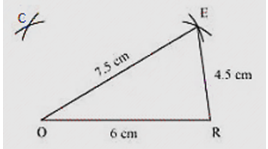
(3) Join C to 0 and E.

CORE is the required parallelogram.
(iv)We know that all sides of a rhombus are of the same measure.
Hence, WE = ES = ST = TW
A rough sketch of this rhombus can be drawn as follows.
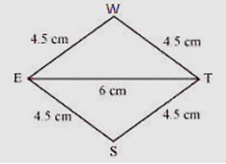
(1) \(\Delta WET\) can be constructed by using the given measurements as follows.
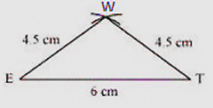
(2) Vertex S is 4.5 cm away from vertex E and also from vertex T. Therefore, while taking E and T as centres, draw arcs of 4.5 cm radius, which will be intersecting each other at point S.
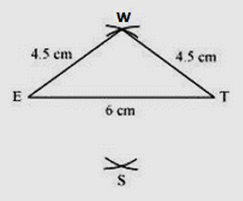
( 3 ) Join S to E and T.
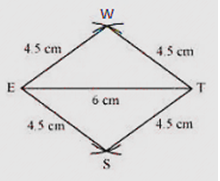
WEST is the required rhombus.
EXERCISE 4.2
Question 1: Construct the geometry of the following quadrilaterals by the given data.
i) Quadrilateral of the word called GIFT
GI= 4 cm
IF= 3 cm
TG= 2.5 cm
GF= 4.5 cm
IT= 4 cm
ii) Quadrilateral BOLD
OL =7.5 cm
BL=6 cm
BD=6cm
LD =5 cm
OD=10 cm
iii) Rhombus MEND
MN=5.6 cm
DE=6.5 cm
Answer:
The rough text of the quadrilateral can be drawn here:
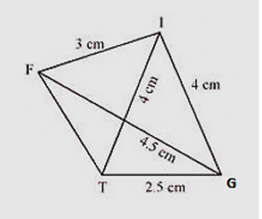
\(\Delta GIT\)can be constructed by following measurements
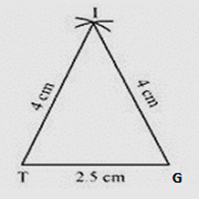
2) Vertex F is 4.5 cm away from vertex L and 5 cm away from vertex I. Therefore, while taking L and I as centres, draw arcs of 4.5 cm radius and 3 cm radius respectively, which will be intersecting each other at point F.

3) Join F to T and F to I.
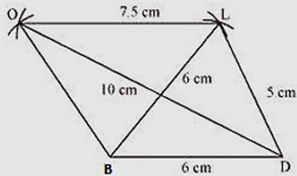
BEAT is the required to form the quadrilateral.
ii) A rough sketch of this the diagram quadrilateral can be as follows.

1) \(\Delta GDL\)can be constructed by following measurements of the quadrilateral

2) Vertex O is 10 cm to the vertex D and 7.5 Cm from vertex L. Therefore, while taking D and L as centres, draw arcs of 10 cm radius and 7.5 cm radius respectively. These will intersect each other at point O.

3) Join O to L and B.

4) BOLD is the required quadrilateral.
iii) We know that the diagonals of a rhombus always bisect each other at \(90^{\circ}\).Let us assume that these are intersecting each other at a point O in this rhombus.
Hence EO=OD=3.25
A rough sketch of the rhombus can be drawn as follows:

1) Draw a line segment MN of 5.6 cm and also draw its perpendicular bisector. Let it intersect the line segment MN at point O.
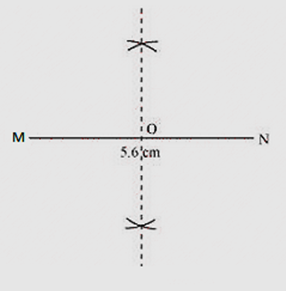
2) Taking O as centre, draw arcs of 3.25 cm radius to intersect the perpendicular.

3) Join points D and E to the points B and N.

MEND is the required quadrilateral.
Exercise 4.3
Question 1:
Construct the quadrilaterals.
(i) Quadrilateral EROM
Side MO = 6cm
Side OR = 4.5cm
\(\angle M=60^{\circ}\)
\(\angle O=105^{\circ}\)
\(\angle R=105^{\circ}\)
(ii)Quadrilateral NALP
PL = 4cm
LA = 6.5cm
\(\angle P=90^{\circ}\)
\(\angle A=110^{\circ}\)
\(\angle N=85^{\circ}\)
(iii)Parallelogram RAEH
EH = 5cm
AE = 6cm
\(\angle R=85^{\circ}\)
(iv) Rectangle YAKO
KO = 7cm
AK = 5cm
Answer:
(i)
(1) Sketch the figure of the quadrilateral

(2) Using the geometry tools draw the line segment OM 6cm and an angle of \(105^{\circ}\) at point O. As vertex R is 4.5cm away from the vertex O, cut a line segment RO of 4.5cm from this ray.

(3) Again, draw an angle of \(105^{\circ}\) at point R.

(4) Draw an angle of \(60^{\circ}\) at point M. Extend this ray so that it meets the previously drawn from R at point E.

EROM is the desired quadrilateral.
(ii)
(1) Total sum of the interior angles of quadrilateral is \(360^{\circ}\)
In quadrilateral NALP, \(\angle P+\angle L+\angle A+\angle N=360^{\circ}\)
\(90^{\circ}+\angle L+110^{\circ}+85^{\circ}=360^{\circ}\) \(285^{\circ}+\angle L=360^{\circ}\) \(\angle L=360^{\circ}-285^{\circ}=75^{\circ}\)
(2)Draw a rough diagram of quadrilateral

(3) Construct a line PL of 4cm and draw an angle of \(75^{\circ}\) at point L. As vertex A is 6.5cm away from vertex L, cut a line segment LA of 6.5cm from this ray.
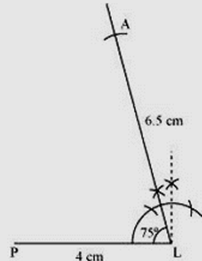
(4) Draw another angle of \(110^{\circ}\) at point A.
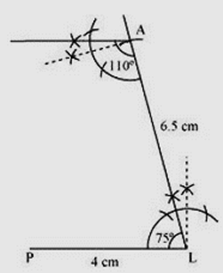
(5) Construct an angle of \(90^{\circ}\) at point P. This line will meet touch the previously drawn ray from A at point N.

NALP is the required quadrilateral
(iii)
(1)Sketch a rough diagram of this quadrilateral as follows
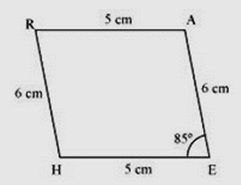
(2)Construct a line segment EH of 5cm and an angle \(85^{\circ}\) at point E. As vertex A is at a distance of 6cm and 5cm, draw arcs from point H and A respectively. These will be intersecting each other at point R.

(3) Vertex H and A are 6 and 5cm away from vertex R. By taking radius as 6cm and 5cm, draw arcs from point H and A respectively. These will be intersecting each other at point R.
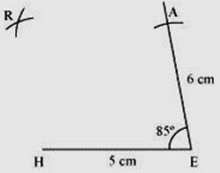
(4) Join H and A with point R

RAEH is the desired quadrilateral.
(iv)
(1) Draw a rough diagram of this quadrilateral as follows.

(2) Construct a line segment KO of 7cm and an angle of \(90^{\circ}\) at point K. As vertex A is 5cm away from vertex K, cut a line segment AK of 5cm from this ray.

(3) Draw two arcs of radius 5 cm from points O and K respectively. These arcs intersect at Y and A.

(4) Join AY
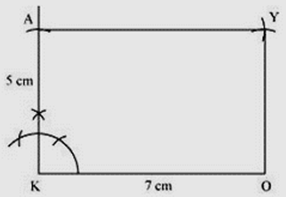
It is the desired rectangle YAKO
Exercise 4.4
Question 1:
Construct the given quadrilaterals.
(a) Quadrilateral ABCD
AB = 4cm
BC = 5cm
CD = 4.5cm
\(\angle B\) = \(60^{\circ}\)
\(\angle C\) = \(90^{\circ}\)
(b) Quadrilateral PQRS
PQ = 3.5cm
QR = 3cm
RS = 4cm
\(\angle Q\) = \(75^{\circ}\)
\(\angle R\) = \(120^{\circ}\)
Answer:
(a) Quadrilateral ABCD
(i) Draw a rough sketch of the given quadrilateral as given below.
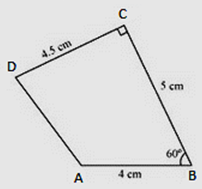
(ii) Draw a line segment AB of 4 cm and mark an angle of \(60^{\circ}\) at point B. Cut a line segment BC of 5 cm from its ray as vertex B is 6 cm away from vertex B.
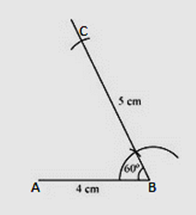
(iii) Draw an angle of \(90^{\circ}\) at point C. Cut a line segment DC of 4.5 cm from its ray as vertex C is 4.5 cm away from vertex C.
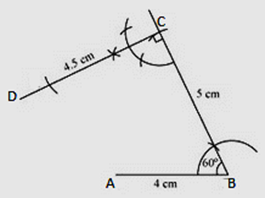
(iv) Join A to D.
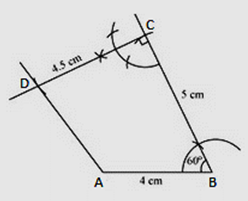
Thus we get the required quadrilateral ABCD.
(b) Quadrilateral PQRS
(i) Draw a rough sketch of the given quadrilateral as given below.

(ii) Draw a line segment QR of 4 cm and point R make an angle of \(120^{\circ}\). Cut a line segment RS of 5 cm from its ray as vertex S is 5 cm away from vertex R.

(iii) Draw an angle of \(75^{\circ}\) at point Q. Cut a line segment QP of 4.5 cm from its ray as vertex P is 4.5 cm away from vertex Q.

(iv) Join P to S.

Thus we get the required quadrilateral PQRS.
Exercise 4.5
Question 1:
Draw the quadrilateral according to the given information.
Draw the square BEST with the length 6.1 cm.
Answer:
BE = 6.1 cm
Steps to construct the square
(i) Draw BE = 6.1 cm. Construct an angle of \(90^{\circ}\) at point E and at point B.
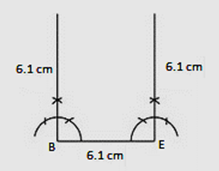
(ii) Vertex T and S are 6.1 cm away from point B and E respectively. Therefore cut the line segments SE and BT of 6.1 cm.

(iii) Join T to S.

Thus we get the required square BEST.
Question 2:
Draw the rhombus according to the given information.
Measurements of the diagonals are 4.2 cm and 5.4 cm long.
Answer:
In any rhombus, diagonals are perpendicular to each other.
(i) Draw a line segment PR of 4.2 cm and draw a perpendicular bisector of PR. Let the point of intersection be M.
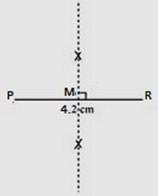
(ii) Draw arcs of \(\frac{5.4}{2}\) = 2.7 cm on both the sides of the perpendicular bisector. Let the point of intersection of arcs and perpendicular bisector as S and Q.

(iii) Join points S and Q with points P and R.

Thus we get the required rhombus PQRS.
Question 3:
Draw the rectangle according to the given information.
Measurements of the adjacent sides are 6 cm and 3 cm long.
Answer:
In rectangle, opposite sides have same lengths and measure of all the interior angles is \(90^{\circ}\).
(i) Draw line – segment PQ of 6 cm and draw an angle of \(90^{\circ}\) at point P and Q.

(ii) Vertices R and S are 3 cm away from point Q and P respectively. Thus, arcs cut the line – segments PS and QR, 3 cm away.

(iii) Join S to R.
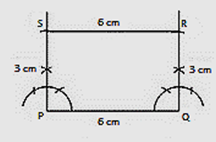
Question 4:
Draw the parallelogram NICE according to the given information.
Measure of NI = 7 cm and IC = 4.5 cm long.
Answer:
In parallelogram, opposite sides have same length and they are parallel to each other.
(i) Draw a line – segment NI of 7 cm and a ray at point I at any angle.
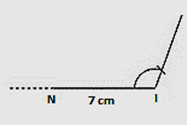
(ii) Draw a ray from point O which is parallel to the ray at I. The vertices E and C are 4.5 cm away from vertices N and I respectively. Cut the line – segments IC and NE of 4.5 cm.

(iii) Join E to C.

Thus this is the required parallelogram NICE.